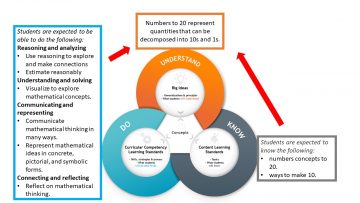Guest post by Ariane faria-dos santos, Peer Mentor, PHD student EDCP 2022
The BC curriculum presents some challenges for teachers to plan because it requires that teachers combine Big Ideas, Contents, and Competencies. The purpose is to create clear goals which will guide teachers to design assessments and activities to develop concepts and skills in their students.
However, given the multiple possibilities of combining Big Ideas, Contents, and Competencies, teachers or teacher candidates may feel overwhelmed while planning without understanding how to balance these three elements.
With this challenge in mind, I’ve tried to unpack the steps of planning and propose a possible teacher’s journey through an iterative process of design using the new BC curriculum.
This video titled: Know Do Understand Model provides a very brief overview of the initial stages of the approach noted below (thank you Lexie, peer mentor 2021-22, for included it)
Step 1: integrating Big Ideas, Contents, and Competencies

Source: Adapted from Ministery of Education (2022, January 31). Curriculum Overview. https://curriculum.gov.bc.ca/curriculum/overview
One first step to plan might be to select a Big Idea that a teacher wants to develop with their students through this Unit Plan.
For example, if teachers want to develop the Big Idea that “Numbers to 20 represent quantities that can be decomposed into 10s and 1s” (first-graders Big Idea), teachers will need to choose the Content and Competencies aligned with that Big Idea.
The math example beside shows some first-grade Content and Competencies that teachers can choose to develop this Big Idea. In this sense, teachers can choose the contents of “numbers concepts to 20” and “ways to make 10”. Teachers can also choose several competencies that students will do to demonstrate that they have learned the Contents and Big Ideas of this unit planning.
In addition, it is essential to pay attention that any Content or Competence that does not help to develop this Big Idea should not be included to not generate a loss of focus on this lesson planning. For example, the Content “addition and subtraction to 20 (understanding of operation and process)” should not be included because it does not help to develop the big idea chosen as the main focus of the lesson planning.
Step 2: integrating other relevant principles, subjects, and purposes
As a next step, I like to consider other principles, subjects, and purposes that I might include to make this lesson planning richer and more interested to their students.
- Are there any first peoples principles of learning that are aligned with step 1?
- Are there any ADST skills that I can include in this lesson planning?
- Are there other subjects that may be integrated into this lesson planning?
- Are there any other important principles to me as a teacher that can be integrated and aligned into this plan?
The only caution is that teachers should pay attention if the other points chosen are coherent with step 1 or if they are changing the main focus of the lesson planning.
Step 3: understanding my students’ prior knowledge, needs, and curiousities
My third step is to understand what students already know about these Big Ideas, Content, and Competencies with the purpose to discover the entry point in planning a sequence of lesson briefs (or, one might call this a pathway).
For example, in the example above a teacher should understand (or learn) their students’ background knowledge related to number sequence, how they count, if they are able to skip and compare numbers, etc. This prior knowledge will be essential to teachers design the more appropriate sequence for students to learn the Big Ideas, Content, and Competencies of this lesson planning. For a teacher just meeting their learners, they will want to incorporate some prior learning assessment during the first few lessons in a given Unit.
As you plan assessment and lessons, it is invaluable to consider the needs of students regarding learning. Teachers should think about the diverse learners in their classroom and plan to attend to their needs which can be related to ELL, modified programs, career, etc. Universal Design (UDL) suggests incorporating multiple ways of communicating and allowing students to represent learning in varied, multi-modal forms.
Finally, I like to consider the particular interests and curiosities of my students, planning lessons that engage students in the teaching and learning process.
Step 4: designing the units of my lesson planning
Now that teachers know the point they should start (step 3) and what they want to achieve (step 1), teachers should divide their lesson planning into several units (step 4) to design a pedagogical path to students achieve the lessons’ goals.
- How should I divide the Content and Competencies to achieve the Big Idea?
- How many units? How many classes are in each unit?
- Which Contents and Competencies should be put together in each unit/ class?
- Which are the Contents and Competencies simpler? How do they progress in each unit/class?
- How should I start each unit/class?
There are many ways of answering these questions and teachers should consider what will more support their students’ learning process.
If you want some suggestions and ideas, you can visit the Learning Design Blog
Step 5: designing the assessments
The fifth step is related to designing all formative and summative assessments for this lesson planning. Teachers should plan when they need to understand if their students have learned and design assessments to collect pieces of evidence of learning. Teachers should also consider when to choose formative or summative assessments and the format of each of them (written, oral, in a group, etc).
- How should I give feedback to my students regarding their learning process?
- When do I need formative assessments throughout the lesson planning?
- When do I need summative assessments throughout the lesson planning?
- What format should they have?
- Should I propose performance assessments?
- Should I use technology to support my assessment practices?
If you want some suggestions and ideas, you can visit the Learning Design Blog
Step 6: designing the learning activities
My next step in pre-planning is to design an outline of the learning activities that will give opportunities for students to develop skills and knowledge. These activities will ‘lead’ students to proficiency on the final Big Idea, Contents, Competencies in the Unit.
- How long do I have for each lesson (may vary depending on your schedule and how much this unit integrates across the curriculum)
- What are my objectives for each lesson? How do these link back to the overall unit objectives?
- How many activities will my students develop in each class? Should they work individually, peers, in a group? What resources or strategies might I include? What digital tools or other manipulatives/hands-on learning will I integrate?
- What kind of assessment will I incorporate? Initially, Assessment as and for learning including formative assessment to help guide the teaching and learning.
Video Overview
Below you can see a wonderful example of Language and Art Unit Planning from the BC Curriculum designed by Janis Sawatzky, Langley School district:
Planning Templates:
There is no ‘one way’ – that said, here are a couple that some teacher candidates have found helpful
- Unit-Plan-template-2015 (Backwards Design with prompts)
- Unit-Plan-Template_Custom (a unit template I collaboratively designed with a TC from the Indigenous cohort to meet their planning needs)
- A lesson plan based on the KDU model (includes ‘teacher says/does’ and ‘student says/does’)
- Adapted T and S say do lesson plan (includes teacher says/does and students say/do – more linear than above example)
For more on Planning for BCs Curriculum include examples, templates and tips, please visit:
Designing Learning Blog, UBC, Teacher Ed
Guest post by Peer Tutor Ariane Faria dos Santos (Ph.D. EDCP), Dec. 2021; Edited by Yvonne Dawydiak, Learning Design Manager, Teacher Education
KDU image reference: BC Ministry of Education https://youtu.be/lXyyZql2PZQ
Modified image (shown above with curriculum filled in) courtesy A.F.S Template – BC Curriculum


Thank you so much, for this article. As one of the consultants, it guided me in preparing unit plan activities for the Learning Resource Handbook for Learners with Disabilities with the Bureau of Learning Delivery-Student Inclusion Division (BLD-SID), Deped, Philippines.
Thanks for the feedback and glad you found it useful. All of our work her is shared under a Creative Commons non commercial share alike with attribution license so it’s always great to hear of educators using it for their work!